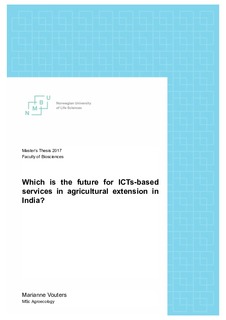| dc.contributor.advisor | Nicolaysen, Marie | |
| dc.contributor.advisor | Lieblein, Geir | |
| dc.contributor.advisor | Breland, Tor Arvid | |
| dc.contributor.author | Vouters, Marianne | |
| dc.coverage.spatial | India | nb_NO |
| dc.date.accessioned | 2018-01-15T12:53:02Z | |
| dc.date.available | 2018-01-15T12:53:02Z | |
| dc.date.issued | 2017 | |
| dc.identifier.uri | http://hdl.handle.net/11250/2477567 | |
| dc.description.abstract | This report aims to deliver a state-of-the-art of new opportunities in information dissemination in rural India. Today, agricultural information transfer mechanisms are mostly generated by the public agricultural extension systems (Department of Agriculture, State Agricultural University etc.), which are often criticized for the linear and inflexible nature of the information transferred. AES have difficulties to meet farmers’ needs and ensure rural development, and show low level of outreach and satisfaction within the farming community. To cope with the new challenges from globalization exposure, the AES should play a wider role than enhancing agricultural productivity through technology transfer. Agriculture is fast changing, and ensuring livelihoods and rural development is becoming more and more complex. | nb_NO |
| dc.language.iso | eng | nb_NO |
| dc.publisher | Norwegian University of Life Sciences, Ås | nb_NO |
| dc.rights | Attribution-NonCommercial-NoDerivatives 4.0 Internasjonal | * |
| dc.rights.uri | http://creativecommons.org/licenses/by-nc-nd/4.0/deed.no | * |
| dc.title | Which is the future for ICTs-based services in agricultural extension in India? | nb_NO |
| dc.type | Master thesis | nb_NO |
| dc.subject.nsi | VDP::Landbruks- og Fiskerifag: 900::Landbruksfag: 910 | nb_NO |
| dc.description.localcode | M-AE | nb_NO |

